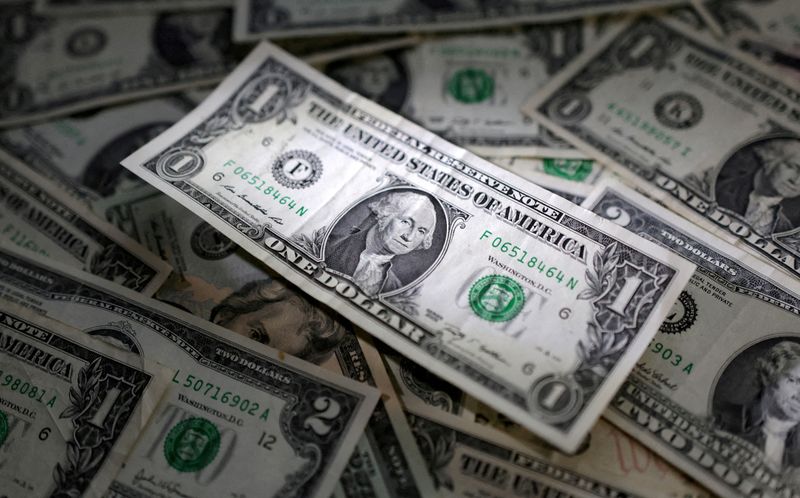By Davide Barbuscia
NEW YORK (Reuters) – Shifting views on the Federal Reserve’s monetary policy trajectory are roiling the U.S. Treasury market, as investors gauge how close the central bank is to pulling back from its aggressive monetary policy tightening.
Benchmark 10-year yields tumbled at the start of the week as investors reacted to the widening conflict in the Middle East and dovish comments from Fed officials, who leaned into the possibility that interest rates may not need to go higher.
But yields, which move inversely to bond prices, rebounded on Thursday, following a stronger-than-expected U.S. inflation report and sparse demand at the Treasury’s 30-year government bond auction. The 10-year yield on Thursday afternoon stood at about 4.7%, some 18 basis points from the 16-year highs touched last week.
The volatility in Treasuries – which has rippled out into equities and other risk assets – is likely to continue until the market gets a definitive signal that the Fed is preparing to downshift, investors said.
“The market needs to really see a slowing in the data before it believes the Fed is on a pause,” said Leslie Falconio, head of taxable fixed income strategy at UBS Global Wealth Management. “Every time the Fed pauses, yields come down, but the market is not convinced they’re quite there yet.”
Fed Vice Chair Philip Jefferson and Dallas Fed President Lorie Logan both said on Monday that the recent run-up in yields may be tightening financial conditions and could preclude the need for further rate increases.
Their remarks bolstered the case for investors’ betting the central bank is close to pausing its hiking campaign.
“We think that the move up in yields may have gone far enough for the time being and we might expect a period of consolidation,” Mark Dowding, chief investment officer at BlueBay, RBC Global Asset Management, said in a note earlier this week.
There’s plenty of evidence that financial conditions, which reflect the availability of credit in the economy, have tightened in recent months.
Credit market spreads have widened as investors demand a higher yield on riskier assets, such as corporate bonds. Real yields, which show what investors stand to earn on Treasuries when inflation is stripped out, stand near 15-year highs, while the Goldman Sachs financial conditions index was recently at its highest level in nearly a year.
A significant chunk of the market appears to believe that yields are indeed headed lower. A Reuters poll published on Wednesday showed that strategists expected the U.S. 10-year yield to fall to 4.25% by year-end.
Fed funds futures show investors pricing in a roughly 15% chance of the central bank’s raising rates next month, from around 27% last week.
NOTHING BROKEN
On the other hand, hopping aboard rallies in U.S. government bonds has been risky this year, with the Treasury market on track for an unprecedented third straight annual loss, and many investors remain hesitant to bet on a sudden turnaround.
There has been little of the chaotic trading or economic pain that would suggest tighter financial conditions are severely denting investors’ risk appetite to the point of spurring a sustained rally in bonds, said Edward Al-Hussainy, senior currency and rates analyst at Columbia Threadneedle.
Data on Thursday showed U.S. consumer prices increased slightly more than expected in September, following a strong jobs report last week.
The S&P 500, though down 5% from its highs, is still up 14% year-to-date while the Nasdaq Composite Index is up 32%.
“Usually you would have a very violent price action in risk assets, a sharp widening of credit spreads, a big ramp-up in volatility … or we have learned something about the fundamentals in the economy,” said Al-Hussainy. “But nothing like that has happened.”
Al-Hussainy said he was maintaining exposure to the short end of the Treasury curve and avoiding long-term bonds. “We feel pretty good not sticking our necks out right now, it feels premature.”
In addition to a resilient economy, factors that have pushed yields to fresh highs in recent weeks could keep pressuring markets regardless of a possible Fed pause.
Among those are worries that investors will demand higher payouts to soak up a wave of government issuance that could nearly double to $1.9 trillion in 2024, according to estimates from Neuberger Berman.
“Without something ‘breaking,’ many of the fundamental drivers of the sell-off may continue to leave long-end yields in search of a peak,” said Jonathan Cohn, head of U.S. rates desk strategy at Nomura Securities International.
(Reporting by Davide Barbuscia; Editing by Ira Iosebashvili, Megan Davies and Leslie Adler)
